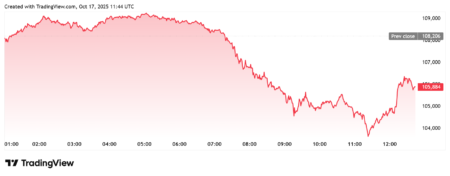Bitcoin Price Analysis: Will BTC Rebound or Drop Further?
The Bitcoin price has recently experienced a significant decline of 5.13% over the past 24 hours, with the cryptocurrency trading at $105,217.60. This drop extends a series of corrections that have followed a period of sustained bullish market sentiment. As traders and investors reassess their positions, many long-term holders remain patient, waiting for clearer indicators of stabilization within crucial support areas. In particular, signs suggest that the market may be nearing an inflection point, where buyer confidence could once again take center stage.
Market Conditions: Where is Bitcoin Headed?
Bitcoin faces the possibility of testing the $100K demand zone before attempting any serious recovery. The bearish crossover observed in the MACD indicator further emphasizes a decrease in bullish momentum, indicating the market is still in corrective territory. Historically, the price range between $99K and $101K has acted as a robust support area, often leading to significant rebounds due to liquidity absorption. If Bitcoin manages to stabilize within this zone, it could trigger aggressive buying that targets a reclaim of the $107K mark.
Once Bitcoin successfully retests the $107K level, traders may shift their focus toward the next target: $115K. Achieving this target could signal a shift in the overall market structure, aligning with long-term forecasts that predict a gradual upward trajectory toward $125K. Moreover, a sustained accumulation around the $100K zone would reinforce the bullish case. Ultimately, a daily close above $107K could confirm buyer confidence, while breaking past $115K might restore upward momentum, making it a critical period for Bitcoin.
Impact of Gold’s Rally on Bitcoin Sentiment
Gold’s recent surge to above $4,300 has captivated global investors, reinforcing its position as the second-largest reserve asset worldwide. This parabolic rally indicates a rotation of capital into tangible assets, especially amid broader economic uncertainties. The movement has reignited conversations about the merits of traditional versus digital gold. Notably, economist Peter Schiff voiced criticisms of Bitcoin, noting its 32% decline since August and questioning its effectiveness as a digital counterpart to gold. Conversely, Binance founder CZ urged patience by highlighting Bitcoin’s long-term growth from a mere $0.004 to over $100K.
Historically, Bitcoin and gold share a semi-correlated relationship; when one experiences significant gains, the other tends to consolidate before eventually following suit. Institutional investors increasingly view Bitcoin as a more liquid asset with superior upside potential, particularly during market volatility. While gold’s current dominance could temporarily anchor sentiment towards risk assets, it’s crucial to monitor how these dynamics evolve. Improved macroeconomic conditions may lead to renewed capital inflow into Bitcoin, supporting a potential recovery in the digital asset space.
Current Sentiment and Long-Term Outlook
The current market sentiment surrounding Bitcoin suggests that it remains vulnerable to further declines toward the $100K demand zone before a meaningful rebound could occur. However, supporters of Bitcoin emphasize that the demand zone has consistently proven its strength as a deflationary wall, bolstered by historical patterns of robust buyer engagement. Once the ongoing correction phase stabilizes, it sets the scene for Bitcoin’s potential to reclaim higher price levels like $115K and even progress towards $125K. Thus, the current dip may serve as a final testing ground before a decisive recovery phase initiates.
Moreover, many traders remain optimistic about Bitcoin’s long-term viability as a decentralized currency and investment vehicle. Continued support from long-term holders could catalyze growth, especially if upcoming financial data points to easing economic pressures. The expectation of renewed demand—both from institutional players and retail investors—could further uplift Bitcoin’s market position. As confidence builds, so too could Bitcoin’s probability of regaining lost ground.
Why Support Levels Are Crucial for Bitcoin’s Recovery
Support levels, especially the $100K demand zone, are critical for Bitcoin’s next directional move. Historical data reveal that this area has repeatedly absorbed selling pressure and led to strong rebounds. This time may prove no different, provided Bitcoin can stabilize in this range. Should Bitcoin break significantly below this support, it could signal more extensive bearish trends, attracting further selling pressure.
Conversely, if Bitcoin manages to hold its ground and stabilizes within the demand zone, it could ignite a buying spree aimed at reclaiming higher price levels. A shift toward $107K would not only act as a bullish signal but also encourage further accumulation in anticipation of long-term growth. The consensus among many analysts is that a sturdy recovery will require a decisive rally through critical resistance levels. Only then can Bitcoin reestablish its bullish trajectory and attract a new wave of investors eager to participate in its growth story.
Conclusion: A Turning Point for Bitcoin?
In summary, Bitcoin’s recent price actions reflect a slowing market sentiment that could signal a turning point. With a price drop to $105,217.60 and potential further declines toward the historic $100K demand zone, the stakes are high for all market participants. A rebound from this zone, bolstered by long-term support and positive buyer activity, could lead Bitcoin to reclaim $107K and target higher levels like $115K and $125K.
The ongoing debates in the investment community between the merits of gold and Bitcoin could also shape market sentiment. As traditional assets like gold soar, Bitcoin’s correlation may play a pivotal role in its recovery trajectory. With institutional and retail interest at a crossroads, the next few days are critical in defining the market’s direction. Thus, whether Bitcoin can galvanize enough momentum to overcome resistance and test new highs remains to be seen, but the current landscape is certainly set for an interesting chapter in its ongoing evolution.
















